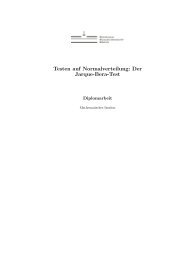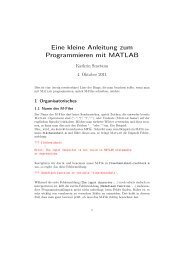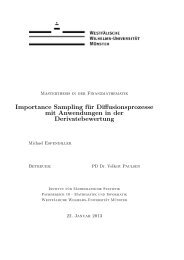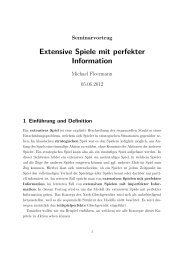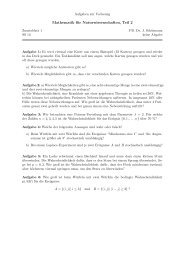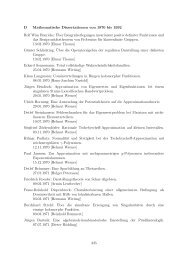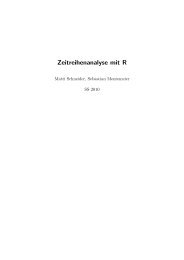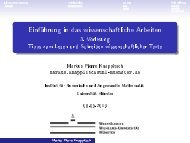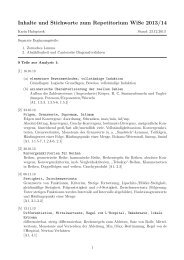Margulis Lemma
Margulis Lemma
Margulis Lemma
You also want an ePaper? Increase the reach of your titles
YUMPU automatically turns print PDFs into web optimized ePapers that Google loves.
STRUCTURE OF FUNDAMENTAL GROUPS 5<br />
sufficiently big. We show that instead these manifolds are nilmanifolds and that<br />
every nilmanifold covers another nilmanifold with maximal first Z p Betti number.<br />
Section 9 contains the proof of Theorem 6 and Theorem 7. Finally, Theorem 8<br />
is proved in section 10.<br />
1. Prerequisites<br />
1.1. Short basis. We will use the following construction due to Gromov.<br />
Given a manifold (M, p) and a group Γ acting properly discontinuously and<br />
isometrically on M one can define a short basis of the action of Γ at p as follows:<br />
For γ ∈ Γ we will refer to |γ| = d(p, γ(p)) as the norm or the length of γ. Choose<br />
γ 1 ∈ Γ with the minimal norm in Γ. Next choose γ 2 to have minimal norm in<br />
Γ\〈γ 1 〉. On the n-th step choose γ n to have minimal norm in Γ\〈γ 1 , γ 2 , ..., γ n−1 〉.<br />
The sequence {γ 1 , γ 2 , ...} is called a short basis of Γ at p. In general, the number of<br />
elements of a short basis can be finite or infinite. In the special case of the action<br />
of the fundamental group π 1 (M, p) on the universal cover ˜M of M one speaks of<br />
the short basis of π 1 (M, p). For any i > j we have |γ i | ≤ |γ −1<br />
j γ i |.<br />
While a short basis need not be unique the non-uniqueness will not matter in<br />
any of the proofs in this article and will largely be suppressed.<br />
If M/Γ is a closed manifold, then the short basis is finite and |γ i | ≤ 2 diam(M/Γ).<br />
1.2. Ricci curvature. Throughout this paper we will use the notation − ∫ to denote<br />
the average integral. We will use the following results of Cheeger and Colding.<br />
Theorem 1.1. [CC96] Let (M n i , p i) G−H<br />
−→<br />
i→∞ (X, p) with Ric(M i) ≥ − 1 i . Suppose X<br />
has a line. Then X splits isometrically as X ∼ = Y × R.<br />
We will also need the following corollary of the stability theorem.<br />
Theorem 1.2. [CC97] Let (Mi n, p i) → (R n , 0) with Ric Mi > −1. Then B R (p i ) is<br />
contractible in B R+ε (p i ) for all i ≥ i 0 (R, ε).<br />
Even more important for us is the following theorem which is closely linked with<br />
the proof of the splitting theorem for limit spaces.<br />
Theorem 1.3. [CC00a] Suppose (Mi n, p i) → (R k , 0) with Ric Mi ≥ −1/i. Then<br />
there exist harmonic functions b i 1, . . . , b i k : B 2(p i ) → R such that<br />
(1) |∇b i j| ≤ C(n) for all i and j and<br />
∫<br />
(2) −<br />
B 1(p i)<br />
∑<br />
∣ ∑<br />
∣ < ∇b<br />
i<br />
j , ∇b i l > −δ j,l + ‖Hess b i<br />
j<br />
‖ 2 dµ → 0 as i → ∞.<br />
j,l<br />
Moreover, the maps Φ i = (b i 1, . . . , b i k ): M i → R k provide ε i -Gromov–Hausdorff<br />
approximations between B 1 (p i ) and B 1 (0) with ε i → 0.<br />
The functions b i j in the above theorem are constructed as follows. Approximate<br />
Busemann functions f j in R k given by f j = d(·, N i e j )) − N i are lifted to M i using<br />
Hausdorff approximations to corresponding functions fj i. Here e j is the j-th coordinate<br />
vector in the standard basis of R k and N i → ∞ sufficiently slowly so that<br />
j



